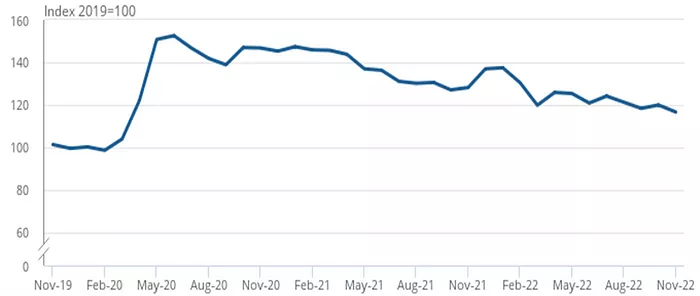Surfing the returns wave

High tides in a cost-of-living crisis
Households across the UK are experiencing increases in prices for mortgages, rent, energy bills, and food. Although the rate of inflation has somewhat stabilised since staggering towards 11.2% in October, ongoing inflation continues to teeter at a 40-year high driving up the cost of living. As disposable income decreases, non-essential items including clothing and footwear will now be considered a luxury.

According to The Office of National Statistics (ONS), retail sales have increased in comparison to pre-pandemic levels. Meanwhile, e-commerce sales decreased by 2.8% in November 2022. This has continued to follow a downward trend as of early 2021 (Figure 1), a huge socioeconomic shift given the size of these markets. After all, the total value of sales in the UK retail market accounted for £421 bn in 2021 with online fashion sales amassing £34.1 bn. The ONS reports that 80% of UK adults have noticed a cost increase in the last month alone. Consumers are already reducing their spending on non-essential items or purchasing the item only to return after assessing personal finances.
Returns: A problem or opportunity?
According to research conducted by Barclaycard, the UK has become notorious for being a nation of ‘serial returners.’ It’s estimated that 67% of consumers will abandon virtual baskets if the returns policy does not meet expectations. Some shoppers will even exploit returns policies leading to the rise of “bracketing” (buying multiple variations of the same item) and “wardrobing” (wearing an item and then returning to receive a full refund). These are new phenomena that indicate excessive returns has become normalised buying behaviour amongst consumers.
Customers now have the expectation for free deliveries and lenient return policies. Already, three-quarters of Gen Z consumers, who buy online on average three times a month will likely return two of those items, according to Circular Online. A returns specialist for retailers, ReBound, analysed millions of transactions to find that 1 in 3 fashion items bought online are returned. This is double the rate for items bought in-store.
UK retailers have been charged approximately £7bn (~$8.4bn) per annum in free returns. Beyond cost, 2.6m tonnes of returned goods are sent to landfills. The wastage is estimated to generate 15m tons of carbon dioxide emissions annually.
In the headlines, retailers are being forced to issue profit warnings. Increased financial uncertainty is set to compound now that the ‘golden period’ for sales has passed. After black Friday and Christmas, peak return season is now looming and coupled with a cost-of-living crisis. Retailers need to be prepared for an influx of returns. Now, more than ever before.
For retailers, the average cost of processing a returned parcel is £20 (~$24) when accounting for the cost of shipping, storage, refurbishing, repackaging, and discounting. Any delays in the processing can result in significant price reductions for resold items online. However, the investment of organisations continues to focus on shipping and logistics instead of addressing the torrent of returns.
The economic and logistical impacts of mass returns remain widely unknown and wilfully ignored. Damaged items are quickly distributed to landfill sites. Alternative disposal methods lack research. Instead, the consequences have become normalised as unavoidable. This is so fashion retailers can rise to the competition in an overly saturated market. After all, lenient returns policies help in securing market share, but only temporarily. For too long, managing returns has been an afterthought. Research into reverse logistics and leveraging data must be explored to address the root causes.
Brands are attempting to take control over returns by introducing more stringent policies including the introduction of a returns fee charged to the customer. Alternatively, gift cards instead of cash or simply the denial of late returns. Retailers have also opted to offer free delivery as part of premium subscriptions to leverage customer loyalty. These strategies push consumers to think twice before making a purchase. However, returns remain a tidal wave due to normalisation. Further action must be taken to distance the concept of returning from the consumer.
Five ways retailers can conquer the returns wave
In uncertain economic times, retailers can still respond to increasing returns rates. Below are five focus areas retailers should consider.
1. Rethinking returns
The choice to return is central to the pre-purchase customer journey as the customer must feel a sense of control. Consequently, current policies should be reviewed to retain customer satisfaction while mitigating increasing return rates.
Fashion retailers typically offer a 30-day return window. However, this can be shortened or extended. Shorter returns windows allow for a quicker re-sale at the highest price points. Moreover, better stock management and protection from ‘wardrobing.’
Longer returns windows ultimately win consumer satisfaction. Lenient timeframes create less urgency enhancing the customer experience and reducing customer service contacts. Meanwhile, a longer returns window decreases the workload on warehouse operations and the overall logistics network. A steady flow will forgo delays that accompany large return spikes over the peak months.
Although controversial, starting to charge the consumer for returns to offset returns processing costs is quickly replacing the norm of free returns. Many industry leading retailers have already adopted this approach with others likely to follow suit.
2. Reviewing operational processes
As rising and widespread inflation makes it difficult for retailers to control external costs, there will be a greater need to ensure internal processes are optimised for cost effectiveness. Retailers have more capacity to engineer procedures internally. However, the greater control and decision-making power over operations must be extensively exercised to overcome the challenge of costs associated with returns.
The reviewal of costs across the returns supply chain can help identify opportunities to drive efficiencies and implement lean methodologies where appropriate.
3. Doubling down on returns data
Lack of investment and understanding in managing returns has meant working with disconnected data systems and disjointed processes. Retailers are overlooking the potential to improve their products by not utilising returns data throughout the entire product development process. This also makes it challenging to link back to customer sales data to help understand sales profiles required to drive loyalty, personalise content and deliver more accurate recommendations for consumers.
Retailers can leverage data and analytics to highlight the root causes of product lines with notoriously high-return rates to prevent returns. Capturing data at every point is vital to better understanding customer behaviour and product category performance.
Additional vigilance is needed to analyse existing inventory data and product reviews. These immediate insights can enable the identification of highly returned product categories or individual SKUs and swiftly execute solutions such as price increases, changes to shipping costs or promotional fluctuations. Data on returns can be utilised at different stages of a product’s life cycle by assessing the performance of a category using full financial analysis, including costs associated with processing returns, and modifying product offerings to focus on specific reasons for returns.
4. Technology is key
We know returns are predominantly driven by issues with size and fit. To address this, retailers can invest in AI-based sizing technology to increase precision when customers select an item. Retailers can also reduce customer propensity to return by empowering consumers with comprehensive information on products to ensure the customer is confident in their selection.
Many retailers are already investing in augmented reality (AR) try-on and fit technology to improve customer satisfaction. Amazon recently launched a virtual try-on service in partnership with Snap in November 2022. This was shortly before the launch of Amazon’s supply-chain management service — AWS Supply Chain — which enables organisations to track and manage cargo flows with increased end-to-end visibility.
Retailers should remain curious to explore and embrace new technologies — such as the metaverse — that will continue to revolutionise the way we shop and the impact of returns. The Slalom Build team worked on a data science and machine learning project by implementing two advanced analytics use cases which predicted the likelihood a product in a virtual basket being returned by a customer. The accuracy demonstrated the possibilities of data science in retail by enabling the team to create actionable insights for predicting product returns and identifying key customer behaviours.
5. Returning sustainably
Online sales are expected to continually grow alongside an increase in returns. Following these trends, retailers need must adapt their business models and maintain operations by implementing sustainable practices without hindering the customer’s experience.
Modern-day customers are becoming increasingly aware of the environmental impacts of returns and deliveries. Therefore, retailers should consider conscious practices in current operations such as going paperless for the returns journey. This is far less wasteful, benefitting both the customer and retailer.
A significant shift in consumer behaviour means shoppers are showing an increased interest in re-wearing, recycling, and renting clothes. Accordingly, fast-fashion retailers need to swiftly explore ways of adapting and future-proofing their business models without it being perceived as greenwashing.
Summary
Fashion retailers are producing more products than ever before. The fast-paced nature of unified commerce coupled with economic uncertainties has led to a high volume of returns. Now more than ever, retailers should be refining and optimising their existing products and returns processes. When following the above focus areas, leveraging technology and data can transform returns management operations. Retailers will finally be able to surf the returns wave, seizing control over customer satisfaction, profits, and reduction of the environmental impact of returns.
At Slalom, we help people and organizations to thrive in turbulent times and connect with their customers by focusing on supply chain optimisation, leveraging data, technology, and in-house expertise to drive results.


